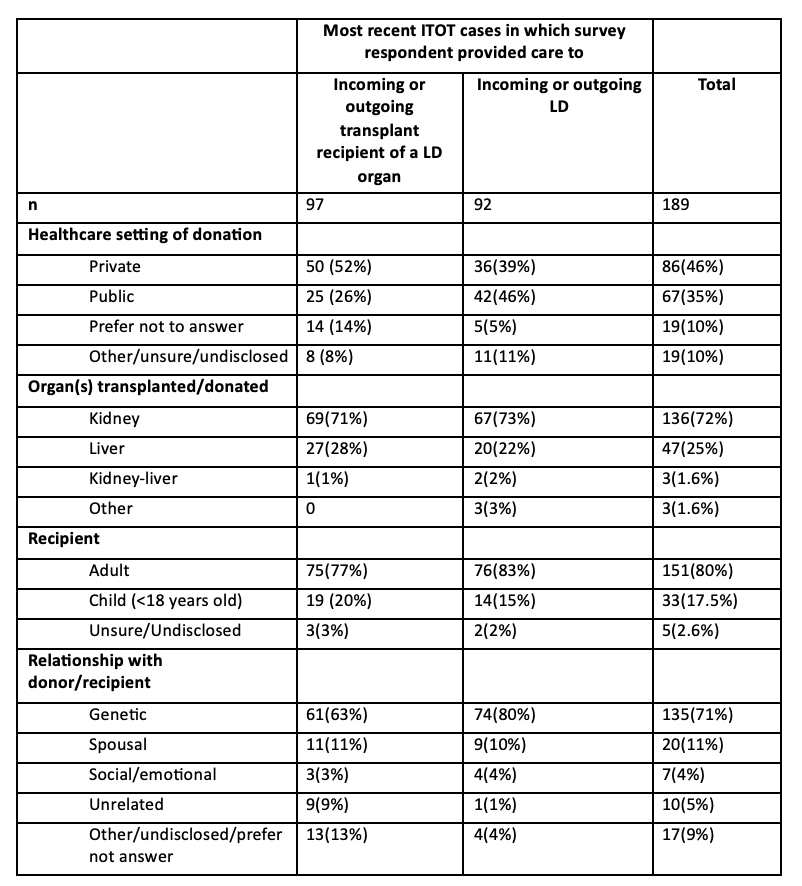Living donor involvement in international travel for organ transplantation: A survey of global activity (1 Jan 2023-31 Aug 2024)
Yashan Jiang1, Georgina Soo1, Amy Lundgren1, P. Toby Coates2, Riadh AS Fadhil3, Jayme Locke4, Maggie Ma5, Mario Martín Gonzales 6, Elmi Muller7, Benita Padilla8, Alicia Perez Blanco6, Maria Dolores Perojo Vega6, Georgina L Irish2,9, Dominique Martin1.
1School of Medicine, Deakin University, Geelong, Australia; 2University of Adelaide, Adelaide, Australia; 3Hamad Medical Corporation, Doha, Qatar; 4NYU Langone, New York, United States; 5University of Hong Kong, Hong Kong, Hong Kong; 6Organización Nacional de Trasplantes, Madrid, Spain; 7Stellenbosch University, Cape Town, South Africa; 8National Kidney and Transplant Institute, Manila, Philippines; 9Australia and New Zealand Dialysis and Transplant (ANZDATA) Registry, Adelaide, Australia
Introduction: In 2023, 35 countries reported ≥747 individuals had travelled internationally for organ transplantation, while 51 countries reported performing >3700 transplants in “non-resident” patients.(1) These Global Observatory on Donation and Transplantation (GODT) data suggest 80% of transplants involving international travel may be from living donors (LDs). However little is known about these LDs, including which organs they donate and where, or their relationships with recipients. We report here on data about LDs collected as part of the 2024 International Travel for Organ Transplantation (ITOT) Survey study, which explored transplant professionals’ most recent experiences of providing care for recipients or LDs involved in ITOT.
Methods: An anonymous global survey of transplant professionals was conducted online (16 Sep-15 Dec 2024). The questionnaire (available in English, French, Mandarin & Spanish) assessed respondents’ most recent experiences (1 Jan 2023 to 31 Aug 2024 inclusive) of each of 4 potential case types: provision of care to an incoming or outgoing LD or transplant recipient. Considering their most recent experience of each type, respondents were asked to provide information about country of residence of LDs and recipients, country where donation and transplantation took place, organ(s) transplanted and type of donor (deceased or living); for all LD cases, they were asked to indicate the nature of the LD-recipient relationship. Data were analysed with descriptive statistics.
Results: 353 individuals from 64 countries completed the survey. 309 were clinically active between 1 Jan 2023 and 31 Aug 2024, of whom 166 (54%) had provided care for ≥1 incoming or outgoing LD or transplant recipient. Of the 164 most recent incoming or outgoing transplant recipient cases reported, 59% (n=97) involved LD transplants. Considering only respondents’ most recent experiences of providing care to incoming or outgoing donors, 68 (42%) reported having cared for ≥1 incoming LD, whereas 24 (15%) had cared for ≥1 outgoing LD. These 92 LDs were from 47 countries who underwent donation in 31 different countries. LDs more commonly donated in private healthcare settings to adult recipients with whom a genetic relationship was claimed (see Table 1). Kidney transplants comprised the majority (72%) of ITOT cases involving LDs.
Conclusion: Most ITOT activity involves LDs yet few professionals report experience in providing care for LDs traveling abroad. While most respondents believed that LDs involved in ITOT were genetically or emotionally related to their recipient, work is needed to evaluate how such relationships are assessed. Nearly half of ITOT involving LDs takes place in the private healthcare setting, thus mechanisms of governance and collection of data pertaining to LDs must be inclusive of the private sector. It is imperative to establish more robust guidance to support long-term care and follow up of individuals who travel internationally for the purpose of donating an organ.
1. GODT. 2025. Organ Donation and Transplantation Activities 2023 Report. Available at: https://www.transplant-observatory.org/wp-content/uploads/2025/02/2023-data-global-report-20022025.pdf

[1] living donor
[2] travel for transplantation
[3] ethics
[4] organ transplantation